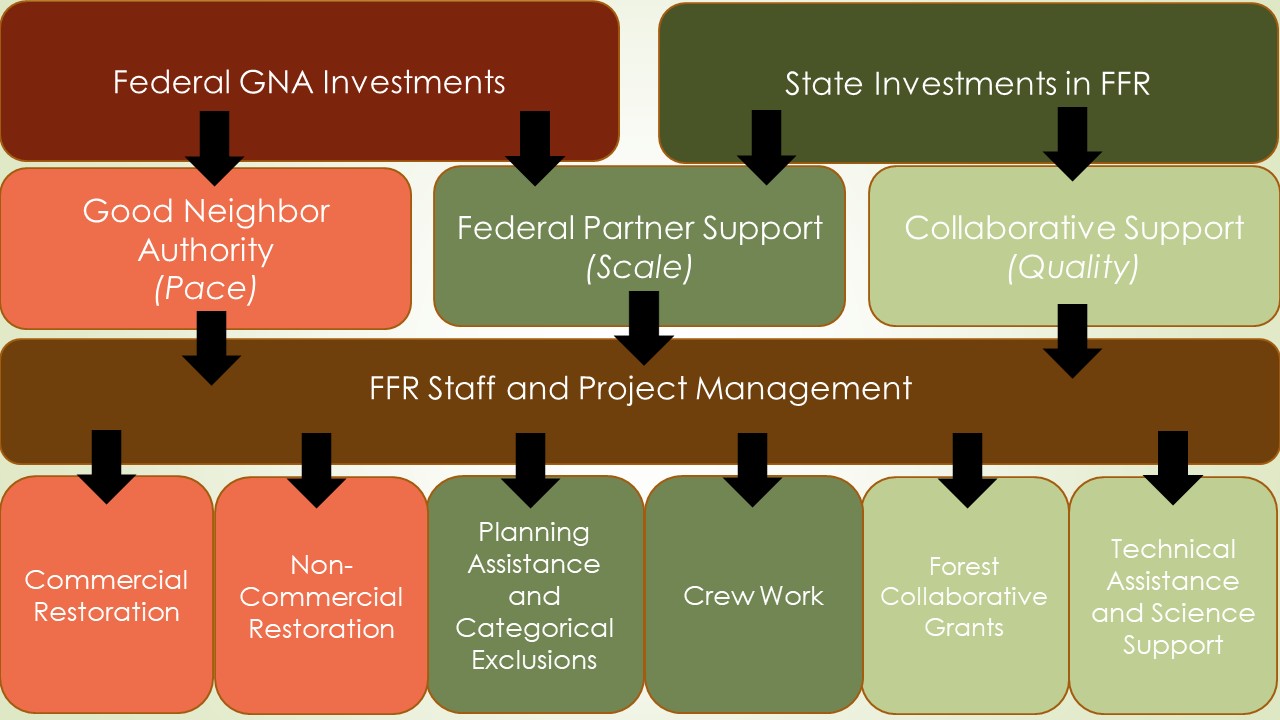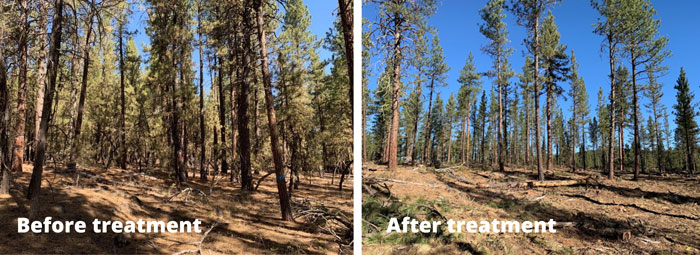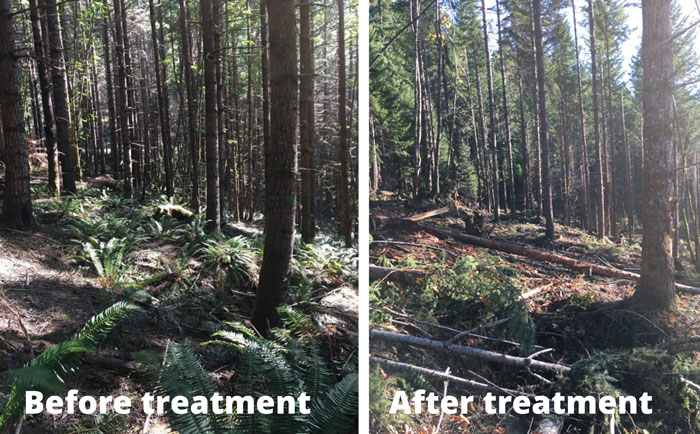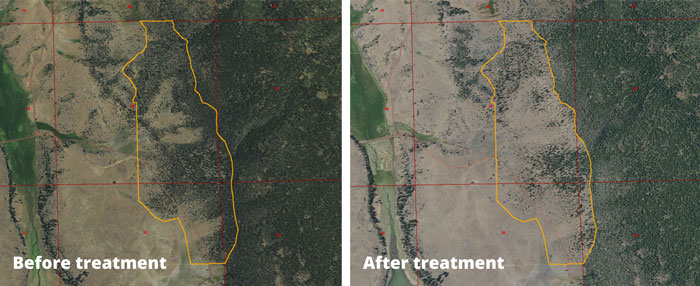Background
The Federal Forest Restoration (FFR) Program was created to accelerate the pace, scale and quality of forest restoration in Oregon's federal forests. The FFR Program seeks to increase the resilience and vitality of federal forests and rural communities and to support and leverage collaborative efforts and regional economies. Forest restoration reduces the risks of high severity fire to forest ecosystems and our communities; recovers degraded habitat for fish and wildlife; and creates employment opportunities in rural communities. Through the FFR Program, the state provides support and resources to increase capacity for federal forest restoration across Oregon.
Program structure and components

Collaborative support
The FFR Program’s Forest Collaborative Grants (FCG) is administered by
OWEB for ODF. The overarching goal of this program is to increase the number, acreage, and complexity of collaboratively planned restoration projects on federal lands in Oregon. The FFR Program makes investments to strengthen the efforts of local forest collaboratives focused on building agreement on vegetation management on either United States Forest Service (Forest Service) or Bureau of Land Management (BLM) managed lands across the state.
Forest Collaborative Grant Application Guidance
2023-2025 Biennium FCG Funding Decisions
2023-2025 Biennium FCG Evaluations
The Technical Assistance and Science Support (TASS) program funds partnership projects between collaboratives and external technical assistance/science support providers to expand the capacity of local collaborative groups to increase the pace, scale and quality of restoration.
2023-25 Biennium TASS Call for Projects
2023-25 Biennium TASS Funding Decisions
2021-23 Biennium TASS Funding Decisions
Examples of past projects include:
- Fire history and stand development studies that provide site-specific information on resilient stand structure and composition
- Outreach and Communications: data collection, planning, product design/development, training
- Workshops, trainings, and other learning and networking opportunities for collaborative group members
- Monitoring to support collaborative learning about the effects of specific treatments or restoration activities (ecological and socio-economic)
- Development of guidance or background documents for topics of collaborative interest
- Collection and analysis of bio-physical data that supports planning of restoration treatments
- Demonstration projects: design, development, implementation, evaluation, communications
Federal partner support
Due to workforce constraints, federal land management agencies
often delay implementation of NEPA-ready projects until federal employees are
available to layout and prepare commercial projects or implement non-commercial
fuels reduction projects. The FFR Program expended $3.3 million between fiscal
years 2014 and 2021 to extend the work season for firefighters to prepare commercial restoration projects and implement non-commercial fuels reduction work. The FFR Program has also deployed
seasonal employees to collect critical data for National Forests, such as stand
exams, to help plan projects.
The Forest Service and BLM have time-sensitive data and analysis needs to keep NEPA planning projects moving forward. The availability of NEPA-ready acres as one of the key limiting factors for increasing the pace, scale and quality of restoration. The FFR Program seeks to help the federal agencies meet those needs and to also help the federal agencies test new methods, build new capacity, and explore new business models through the PACE program.
2023-25 Biennium PACE Call for Projects
2023-25 Biennium PACE Funding Decisions
2021-23 Biennium PACE Funding Decisions
Examples of Planning Assistance and Categorical Exclusion (PACE)-type capacity projects previously funded by ODF's FFR Program include:
- LiDAR imagery, data acquisition, and ground-truth plots
- Botany, Threatened and Endangered Species, or Heritage surveys
- Stand exams
- Innovative use of LiDAR data to reduce the need for additional field data collection or analysis
- Contracting the data collection, analysis, and documentation needed for 70 acre commercial thinning and 3000 acre Insect and Disease Categorical Exclusion projects.
Good Neighbor Authority (GNA)
The Good Neighbor Authority (GNA), authorized under the 2014 Farm Bill, allows the Forest Service and Bureau of Land Management to enter into partnership agreements with state agencies to accomplish forest, watershed, and rangeland restoration projects on federal lands. ODF and the Forest Service have developed project-level agreements on 10 of the 11 National Forests in Oregon since March of 2016, when the Governor, the State Forester, the Director of ODFW and the Forest Service Regional Forester signed the Master Good Neighbor Agreement.
SPAs are partnership agreements where the Forest Service gets additional human resources from the state to perform restoration work and the state gets paid for their work through two pathways. There are two types of SPAs:
Non-commercial (restoration services) SPAs
Under a non-commercial SPA, the Forest Service can use available federal funds to pay ODF to provide restoration services. Examples: Using appropriated Hazardous Fuels funds to accomplish non-commercial thinning or prescribed burning; using K-V deposits to accomplish temporary road decommissioning or create wildlife snags.
Commercial (product removal) SPAs
Under a commercial or product removal SPA, ODF implements commercial restoration treatments on federal forestland via a GNA timber sale contract. Commercially viable forest products removed as a by-product of restoration can be sold to generate revenue (GNA Revenue) which is used to cover costs and accomplish additional restoration both in the project area and across the National Forest. This is similar to Forest Service stewardship contracting - thinning is implemented, and the value of harvested wood is captured to be re-invested in forest restoration. GNA Revenue can be used not only to implement additional restoration projects but also to plan subsequent restoration projects and move them through the NEPA process. GNA Revenue can also be used to monitor previously implemented restoration projects.
View the currently advertised GNA Timber Sales.
Paddock Butte GNA timber sale
Before and after photos of a stand within the Paddock Butte GNA timber sale. This 637-acre commercial thinning took place on the Bly Ranger District of the Fremont-Winema National Forest, and involved improving 6 miles of road, removal of juniper and non-commercial vegetation, and a fungicide treatment for Annosus Root disease.

Cain GNA timber sale
Before and after photos of the Cain GNA timber sale on the Middle Fork Ranger District of the Willamette National Forest. This was a 26-acre thinning in a second growth Douglas-fir plantation. The treatment was intended to reduce stand density, leaving the largest and healthiest trees, and create a stand more resilient to disturbance.

Non-commercial restoration project
An aerial photo of a non-commercial restoration project that involved removal of invasive juniper. This 458-acre GNA service work was funded with the revenue generated from Paddock Butte GNA and other GNA timber sales on the Fremont-Winema National Forest.
